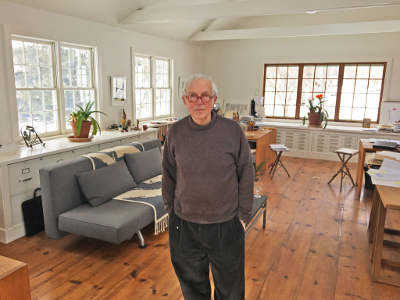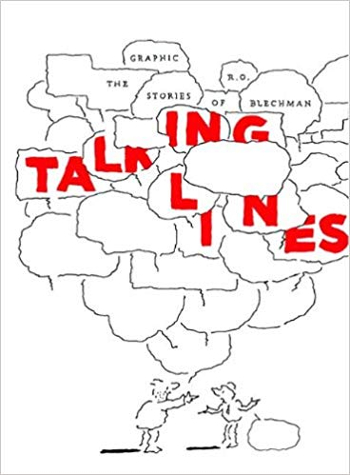Interviewed by J.J. Sedelmaier
When I come across the art of RO Blechman, I'm reminded of the Leonardo da Vinci quote, "Simplicity is the ultimate sophistication." Truly, the simplistic stitched, broken line style in Blechman's drawings is the result of an intuitive effort to narrow down the idea to its most basic form - an approach that combines the art of communication with the communication of art. How fitting it is for J.J. Sedelmaier to meet with his old boss and friend for this interview. Sedelmaier worked with Blechman 1984 - 1990 before launching his own production studio with his wife, Patrice, and brings to the table his own studio experiences with creating graphics, directing animated commercials as well as producing the first two seasons of MTV's “Beavis and Butt-Head”, Saturday Night Live/Saturday TV Funhouse from 1996 to 2000, writing over 60 articles for Print Magazine and more. — Chris Padilla, Editor
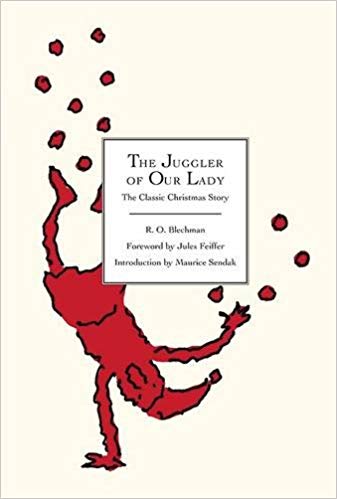 RO: Yeah. The Army grabbed me, and this is a hell of a thing to admit, were girls. [laughter] When I realized that I would be drafted, the Korean war was going on, I didn't want anything to do with the Korean war, so I was helped by an older friend to contact certain people who might give me a good job, which meant not carrying a rifle, but carrying a pen - by that time "The Juggler of Our Lady" had come out, [which was] just after college.
RO: Yeah. The Army grabbed me, and this is a hell of a thing to admit, were girls. [laughter] When I realized that I would be drafted, the Korean war was going on, I didn't want anything to do with the Korean war, so I was helped by an older friend to contact certain people who might give me a good job, which meant not carrying a rifle, but carrying a pen - by that time "The Juggler of Our Lady" had come out, [which was] just after college.
JJ: We'll go into how that got produced because that's obviously had and incredible impact on everything.
RO: Yeah, but what happened is I read a biography of the famous American director, Frank Capra. And by the way, read his biography it's amazing. It was his autobiography, Be it as it may, he mentioned the fact that he worked for Colonel Slingo. I love the name, straight arrow animation. I got in touch with Colonel Slingo, sent him my book, and mentioned my qualifications and then when I was drafted, I was sent to camp Gordon in Georgia which I could do without - because basic training in the Georgian jungle was no fun but I was given, after basic training, an MOS - Military Occupational Specialty - it was a dream. I was assigned to the film school, the film school was in Astoria New York.
JJ: Oh, part of the Signal Corps?
RO: Yeah. A dream. And I turned it down. I turned it down because I was told that I'd be in the front lines not with a rifle, but with a camera, and I said not for me - it was all bullshit and I should have known better and maybe part of me did know better but at least I was sent to Germany but imagine, JJ, if I had gone there I would be a live action film director and probably a god damned good one too, it was a career-changing mistake, just something I continually mistake - that's very interesting - something I continually mistake - something I continually make mistakes about, that's another matter. In any event...
JJ: If that had happened you think that would've taken you away from design and your graphic work? And you would have just been...
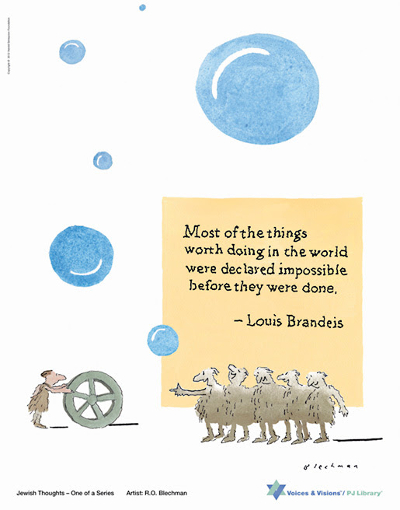 RO: Yeah I'd be a filmmaker. I'd be a live action filmmaker. If you wanted to interview me, call my secretary and she'll set something up for me in Hollywood where I'd be [laughter]. Because I am a filmmaker for Christ's sakes, even in my still stuff, I tell stories. Even my single panel stuff is a story and I think sequentially.
RO: Yeah I'd be a filmmaker. I'd be a live action filmmaker. If you wanted to interview me, call my secretary and she'll set something up for me in Hollywood where I'd be [laughter]. Because I am a filmmaker for Christ's sakes, even in my still stuff, I tell stories. Even my single panel stuff is a story and I think sequentially.
JJ: But perhaps you would have - you've taken the graphic aspect of your storytelling into areas that no one else has and you do work that no one else could even hope to do so, just so you know, I think there are a lot of people that are really happy you didn't go into the signal corps.
RO: Well and I'm not one [laughter]. In any event, I would be doing feature films and...
JJ: Which is something you've always wanted to do.
RO: I've always wanted to do. Why don't you go to the next questions. [laughter]
JJ: Okay so you found yourself - you had done "The Juggler of Our Lady", which kind of put you on the map.
RO: Oh, the book.
JJ: Yeah, the book.
RO: Well the book led to my first job and that was with John Hubley at Storyboard, right after I got out of the army. Hubley invited me to lunch and said 'would you like to join my outfit, Storyboard Inc., doing storyboards?' So that's what I did for a year and a half probably - god damn good pay.
PART 2 -
JJ: Ok, so how did "The Juggler of Our Lady" the book happen?
RO: In college I took a special seminar on humor, of all things - I'm talking about of all things the professor I later learned was a colleague of Luis Buñuel, because I read Luis Buñuel’s autobiography and there was my professor's name. And at the end of the seminar we all had to create projects, I did a graphic novel - it was...
JJ: Before there were even things called graphic novels.
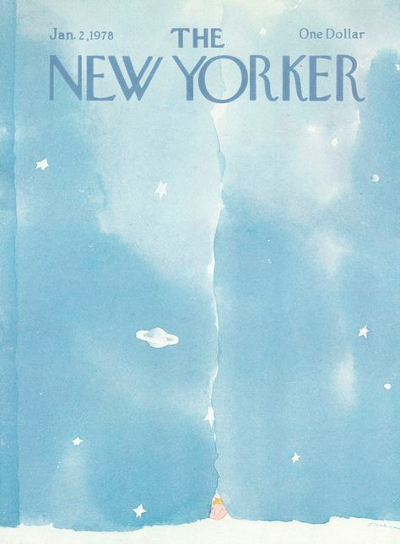 RO: Yeah - but even before then I remember whenever I would have an interesting trip or an interesting experience I would do little booklets which were graphic novellas, but in any event I did one, instead of an A I got a B-, the lowest mark in the class, but the other person who got the lowest mark in the class was William Goldman, [who won the Academy Award for Best Original Screenplay for "Butch Cassidy and the Sundance Kid"] - that's very interesting, the two kids in the class who did the worst and we were probably the only two who went onto careers, crazy. Not so crazy. Sometimes you burn out, sometimes when you're not ready for a career, you - how can I express it - it's not good. You know you have to be mature enough to be able to handle a career in whatever your field happens to be. So let's see - what happened is, I went around with the book and somebody said, it was an art director in an art studio, 'I do book jackets for Henry Holt - why don't you show this thing to Henry Holt'? So I did and the editor said, 'well it's very nice, I like it a lot but I really think we're only interested in seasonal material - if you have anything on Christmas, Thanksgiving we'll consider it but nothing like this'. And that night I called a friend of mine, I said, 'hey do you know any good Christmas stories?' and he said, 'yeah, I know one, it's called the "The Juggler of Our Lady" and it's a good story, why do you ask?' I told him why and I got the short story by Anatole France and I think I did the book in one night - I just sat down and did the damn thing.
RO: Yeah - but even before then I remember whenever I would have an interesting trip or an interesting experience I would do little booklets which were graphic novellas, but in any event I did one, instead of an A I got a B-, the lowest mark in the class, but the other person who got the lowest mark in the class was William Goldman, [who won the Academy Award for Best Original Screenplay for "Butch Cassidy and the Sundance Kid"] - that's very interesting, the two kids in the class who did the worst and we were probably the only two who went onto careers, crazy. Not so crazy. Sometimes you burn out, sometimes when you're not ready for a career, you - how can I express it - it's not good. You know you have to be mature enough to be able to handle a career in whatever your field happens to be. So let's see - what happened is, I went around with the book and somebody said, it was an art director in an art studio, 'I do book jackets for Henry Holt - why don't you show this thing to Henry Holt'? So I did and the editor said, 'well it's very nice, I like it a lot but I really think we're only interested in seasonal material - if you have anything on Christmas, Thanksgiving we'll consider it but nothing like this'. And that night I called a friend of mine, I said, 'hey do you know any good Christmas stories?' and he said, 'yeah, I know one, it's called the "The Juggler of Our Lady" and it's a good story, why do you ask?' I told him why and I got the short story by Anatole France and I think I did the book in one night - I just sat down and did the damn thing.
JJ: Did you have to get any sort of rights or was it all just public domain?
RO: No, Anatole was 19th century so, yeah. They accepted it - all this before I went into the army in 1953- it was fall 1952 and, by the way, the guy who suggested that I go to Henry Holt who was the book jacket designer, did the book jacket for the "Juggler Of Our Lady" and I hated it - it was awful, but I was in the army by the time it was published so I couldn't do my own jacket, it really bothered me.
JJ: Any reaction to the simplicity, sparse style that you were working in?
RO: Yeah, well I had done political cartoons for the college newspaper - and all the stuff was political because I was a very political cat at the time - something of a so-called democratic socialist. Norman Thomas came to speak, he was fantastic by the way, it was - sorry to get off the subject, but he was debating a republican congressman and when the republican congressman was speaking his talk was interrupted by laughter from the audience and the guy was all upset and hardly could carry on. And what happened was while the other was speaking, Norman Thomas was conspicuously picking his nose. [laughter] That guy knew what attracted attention. In any event, no my brain was rotten for many years after, it took a while for me to get to where it is now - my style.
JJ: But the Reaction to your drawings and your layout and your...
RO: Oh it was novel. It was, yeah...
JJ: And he recognized it and it was something that he took to, it wasn't something like, 'well, aren't you going to do more of this?'
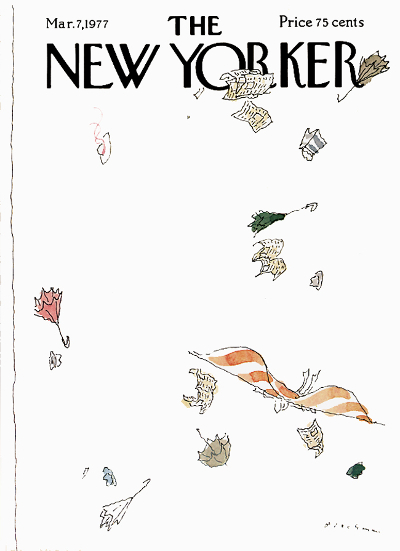 RO: No, no. It's interesting, I found that two pages in it, two of my favorite pages, was something that I wrote in a letter to somebody That's how personal this book was - it was the spread in which I said, I knew the world would never change in fifty years. I would be dead, pink and cocoa balls and hoops would - I can't remember the rest of it and I would be dead and my dust would blow into people's eyes and I had a guy say 'damn' and I realized maybe ten to fifteen years ago this is something that I had transcribed from a letter I had written, I mean, leaving out the pink and cocoa hoop discs, hoops and balls, but I just had - it was interesting.
RO: No, no. It's interesting, I found that two pages in it, two of my favorite pages, was something that I wrote in a letter to somebody That's how personal this book was - it was the spread in which I said, I knew the world would never change in fifty years. I would be dead, pink and cocoa balls and hoops would - I can't remember the rest of it and I would be dead and my dust would blow into people's eyes and I had a guy say 'damn' and I realized maybe ten to fifteen years ago this is something that I had transcribed from a letter I had written, I mean, leaving out the pink and cocoa hoop discs, hoops and balls, but I just had - it was interesting.
JJ: So did the book just take off from the time it was released?
RO: It did. I will never forget and it was very disabling to get that kind of recognition when you're not ready for it. But I remember one sunday, we got the Sunday Herald Tribune and the front page was 'oh my god it's the "The Juggler of Our Lady"! I couldn't believe it.
JJ: And was it because it was a novel approach?
RO: Yeah, I mean, in truth there had been graphic novels before and as you well know, you could probably name a few. Milt Gross, didn't he do a graphic novel?
JJ: Yeah, “He Done Her Wrong” without any text.
RO: Yeah he didn't know anything about graphic novels, I didn't know anything, just coincidentally both happened to come across the creative form.
JJ: They were just illustrated books, they were just cartoons.
RO: Exactly.
JJ: So you had an established existence as a successful cartoonist.
RO: Age twenty-two.
JJ: Age twenty-two! Did you ever have any problem with being called a cartoonist?
RO: No I didn't even care. I mean, Saul Steinberg - that he was called a cartoonist - if it was good enough for him it's fine with me. It's the work that counts who cares how it's classified or described.
JJ: So Hubley saw "The Juggler of Our Lady"?
RO: Yeah.
JJ: And he had Storyboard and...
RO: Yeah and he asked me to do storyboards so that's what I did, but my style was never used - it would go to people like Tony Eastman's father.
JJ: Got ya. Phil Eastman, ok.
RO: Yeah because my stuff was very commercial and also it was then difficult to animate - all this broken line stuff.
JJ: Was it John Hubley who said, "We can animate your stuff, it doesn't make any difference"?
RO: Well he did, yeah, there was a live action short with Dizzie Gillespie, it was Dizzy Gillespie playing an advertising executive who was showing a rough to a client and the rough happened to be my rough animation and it was animated by Bill Littlejohn.
JJ: Oh wow!
RO: Oh wow is right!
JJ: Who you worked with well into the 80s and probably 90s.
RO: Oh yeah, I remember he once did a marvelous sequence for this Stravinsky "Soldier's Tale" and he called me up and he said, "Hey, if you don't want to use it you don't have to because I don't like it". And I said, you have to be kidding this stuff is great! "Well are you sure?" Yeah! And there he was in California animating it - these are animators who just take off, you give them an idea and they're off and running. They contribute, they add this stuff, and that's the mark of any good craftsman.
JJ: That's also what's interesting about the "Soldier's Tale", is you can tell all the different animators that worked on your stuff by looking at the sequence but it all holds together just beautifully.
RO: every now and then Tissa [David] would come in and add a little something but it does hold together I mean I still grim-MASS when I come across it.
JJ: Most people grimace by the way.
RO: Ok!
JJ: Because you're beside yourself. [laughter]
RO: It's so bad I have to grimace! But no, it works because the story goes all over the place and the music goes all over the place so the animation goes all over the place although sometimes the animation is a very banal standard - I can't find the word - conventional - but you know I had just so much money - which is so little money- and I had to do what I had to do and so I wasn't able to use Tissa David and Bill Littlejohn and Ed Smith and some of the other wonderful animators whose names I'll forget, unfortunately. So I had to use people who were around.
JJ: No, it came out great, it still came out great!
RO: Yeah it was a fine film.
JJ: So did this particular project come up after the Gillespie thing?
RO: That was done after I was there for many many months, maybe I was there for a year. No, you wanted to do a live action film with Dizzy Gillespie and you wanted this animation and he wanted it to be bad and he used my style.
JJ: He wanted it to look like just rough and naive or...
RO: In other words, Dizzy Gillespie is selling the client a rotten project and the rotten project has a rotten drawing so that was the fun of it, but it got me out to California for a week or two, working with Bill Littlejohn
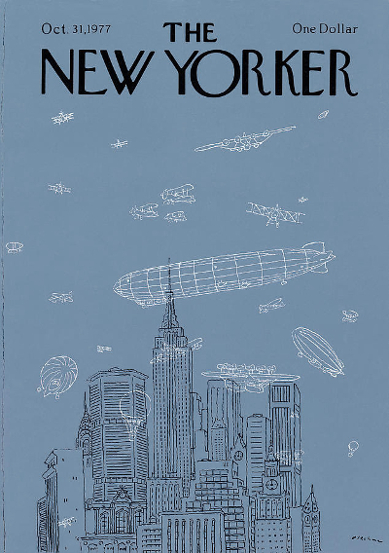 JJ: Do you have a copy of that film?
JJ: Do you have a copy of that film?
RO: No.
JJ: Because it doesn't sound like something I've ever seen either. And so when...
RO: It was called, "Date with Dizzy".
JJ: Ok and this is in '54?
RO: Yeah.
JJ: Ok. And so when did you start getting commercial animation work on a semi regular basis after that?
RO: After that, yeah. What happened, it's very interesting - I would do storyboards for Elektra films.
JJ: Elektra was on...
RO: 46th street.
JJ: And it was...
RO: Abe Liss.
JJ: Abe Liss and Sam Magdoff.
RO: So what happened is I wasn't very happy sometimes with the way my storyboards were turned into key drawings.
JJ: So they would take your storyboards and do a kind of pseudo-Blechman looking...
RO: Yeah, probably wasn't bad, but I said, 'look I'll do this stuff', so after doing the key drawings Iand figures, why don't I do the in-between stuff? And so I realized, what the hell, I'm doing films!
JJ: So you were actually animating at that time?
RO: No - good for you [laughter]. I worked, I don't remember what, very good question you were asking. I only know that I ended up doing the drawings, I was not animating, I never have animated, but I figured, look if I do the storyboard and if I do - I guess I had done the animation, somebody had done the animation for me - then I re-drew it, and then I figured it's a film. So then I started getting work on my own - I don’t know how - that's a step I can't...
JJ: Well Elektra was a relatively artsy studio.
RO: Very good.
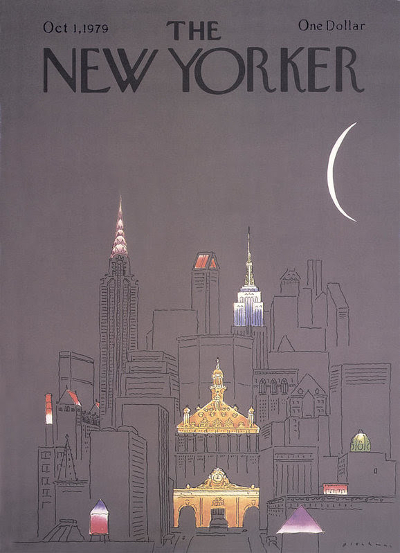 JJ: And Abe was part of UPA? I think he had a background in Disney and UPA and so forth, which was also Hubley as well. So they got your stuff and how it could work as a film. So it makes sense that Elektra would kind of take you under their wing and so forth. I'm trying to figure out how the evolution of you doing work for Electra and perhaps other studios in New York, although I don't know who those would be.
JJ: And Abe was part of UPA? I think he had a background in Disney and UPA and so forth, which was also Hubley as well. So they got your stuff and how it could work as a film. So it makes sense that Elektra would kind of take you under their wing and so forth. I'm trying to figure out how the evolution of you doing work for Electra and perhaps other studios in New York, although I don't know who those would be.
RO: No, I never did work for any other studios in New York.
JJ: Pelican at all? With Jack Zander?
RO: Jack Zander - I know the guy - I don't remember having ever worked for him. I don't remember having worked for anybody but Elektra. What I don't know is how the hell I ever transitioned into my own studio, I do not know.
JJ: Well that had to do with PBS, right?
RO: No.
JJ: Because Elektra would have taken you into the '60's. And by Elektra, I mean, Seymour Chwast was designing their posters.
RO: No, I think something else happened that got me into it. I think what happened was - and this was the beginning of the Ink Tank - I was with the head of PBS, Larry Gorshman, and it happened that he had seen my first cover for the New Yorker. And I don't know where, how and why we met - and I say hey Larry PBS doesn't have a Christmas show- why don't you do a Christmas show? That was when I really started my own animation studio. I used a lot of the people and others who had worked on the film as the animators.
JJ: So what I'm trying to do is fill in the area between Elektra - now Elektra took you- Elektra did Alka Seltzer?
RO: What a good question, yes, of course.
JJ: Ok so it was Elektra?
RO: No question.
JJ: Tinker was the agency and Partners I think? And then you also knew Lou Dorfsman. So the CBS stuff probably came before that?
RO: That was something different. I don't know when I did the CBS spot.
JJ: Late '67? Something like that.
RO: I think so. What happened is, during the holiday season I was at a theatre and I saw that the audience was given a Christmas greeting, which was a slide and I thought to myself, 'this is weird' you know it's 1960-something. What the hell is a 1920s slide doing, so on my own I think I worked with - of course I worked with Electra on that. I had taken a Christmas card I had done, it was a two-page folder - and created a board, and managed to point out, it was Jack Dazzo who animated it.
JJ: Willis Pyle did the Christmas tree, Alka Seltzer was [animated by] Jack Dazzo though.
RO: Thank you. Well in any event it was Elektra who produced it, who financed it really.
JJ: So you pitched the idea to them and it was like a generic thing?
RO: That is correct.
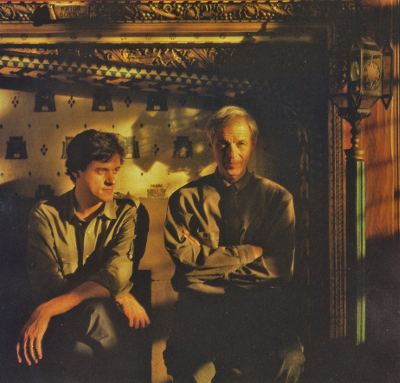
Photo of JJ Sedelmaier and RO Blechman by William Duke 1987
JJ: That's fantastic and either they pitched it to Lou, or they...
RO: No, I pitched it to Lou.
JJ: You pitched it to Lou.
RO: Because I owned it. But how the hell did I own it and they produced it? I don't know.
JJ: Well that's rare but maybe you worked out an arrangement because there were a couple of them - there was the Christmas tree and there was the little girl with the escalator and the Santa.
RO: Much, much later.
JJ: But that was working off of the fact that "Christmas Tree" was probably successful and they said let's do another one and?
RO: Yeah.
JJ: And Lou was this incredible creative director at CBS that was just involved with their whole branding and image and everything. A fantastic guy.
RO: I'm gonna show you something that was done by Lou, I wish I had it handy. Yeah, here it is. Look at this booklet. So elegant, look at that glassy cover [looking at booklet].
JJ: Oh that's wonderful.
RO: Such a shame this isn't a video piece, but isn't it just - but look at that.
JJ: Yeah, he did some wonderful work. It's really incredible work.
RO: Yeah, he was an amazing guy. So I ended up renting it, for years and years and years.
JJ: And it really is - as far as I'm concerned, that CBS Christmas tree piece is one of your best. It's, like you were saying earlier, everything from design to animation to track, too. Oh it's just fantastic. So by this time, late '60s, Electra was starting to go, Electra maybe made it into the early 70s?
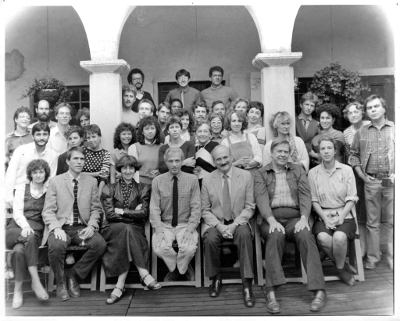
"A Soldier's Tale" Crew - 1984
RO: They expanded. The problem was that they moved from 46th street East of 6th avenue to a very fancy shmancy place on Madison Avenue that formerly occupied Knopf Publishing. So they went over their head financially...and went belly up.
JJ: Actually a lot of - especially animation studios - they feel this obligation to get larger and take on more stuff and more responsibility and they just explode. Colossal Pictures suffered from the same thing, too. Wonderful studio but they just got into everything from Merchandise to long form shows and they no longer had this special existence any longer. But I think of the, OK so we have Alka Seltzer, CBS, Volvo...
RO: Oh that came quite a bit later but that was very important. Volvo, yeah that was Elektra also, how about that.
JJ: How did you meet Tissa?
RO: I don't know.
JJ: Really?
RO: I know how I met Ed (Smith).
JJ: How'd you meet Ed?
RO: I heard about him and so I asked to meet him and in lumbered this great big guy
JJ: He is a bear
RO: And I thought to myself no way is he going to handle my stuff. But I needed to have an animator and he turned out to be Ed Smith. I remember also that in 1960 I happened to be in Spain watching a Flamenco show and the main performer was this really overweight lady and I thought- let's leave - and then she started dancing - I was transfixed with that flamenco dancer.
JJ: Oliver Hardy was very light on his feet as well for being as big as he was. But Tissa did - it's interesting because Ed and Tissa I think of as your two [animators] - I know Bill Littlejohn did a lot of stuff; I know a lot of people have done stuff but those two are the ones that really seem to capture your style and what's interesting.
RO: They expanded on it
JJ: They all do, all good animators do, absolutely. First of all, Ed worked straight ahead, meaning he just puts the pencil down and he just starts going - no in-betweens, no breakdowns, just whoosh - goes straight ahead. Tissa breaks things down. Also Ed articulates - he uses fingers. Tissa has these mitts and they have a completely different style but they both really capture your feeling and move it forward and all of that stuff.
RO : They add.
JJ: But Tissa did Perrier right?
RO: Yes, of course.
JJ: Did she do anything before Perrier?
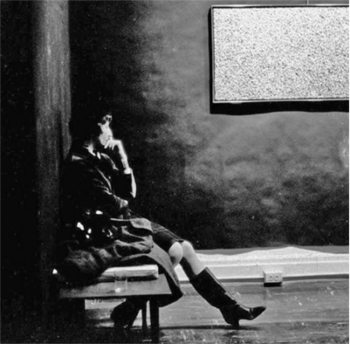
Ray Favata's photograph of the legendary animator Tissa David, animator of the Perrier commercial. Her career in animation spanned over three decades, including animating the Raggedy Ann character for the 1977 film, "Raggedy Ann & Andy," directed by Richard Williams. She was awarded the Winsor McCay Award during the 1988 Annie Awards.
RO: Probably. But offhand I don't know what she had done. But whenever I could, I worked with Tissa. Both very emotional animators.
JJ: Thank god!
RO: They move into my character, they inhabit my character.
JJ: Well, again, all good animators do that.
RO: Yes, that is very true - I think animators get shorted - it bothers the hell out of me. [People] think they just go move something - no, they don't. They act it out.
JJ: Yeah, you really can also cast animators to do certain projects, like you wouldn't necessarily cast Tony Eastman for the same thing you would cast Tissa David for. I remember Tissa animated a tango for us and I asked her ahead of time 'have you ever animated a tango?' and she said “J.J. – I DEED the Tango !”. And I knew I had the right person.
RO: I know that she animated a rock spot and, boy, she was fantastic. That was a music video for I think They Might Be Giants and she was fabulous.
JJ: It's interesting because you mention that you owned the [CBS] tree animation but animators, certainly not animators, but production companies and often even designers and illustrators don't end up owning the stuff that they do. And they certainly don't have an arrangement like actors or voiceover people have in terms of residuals in commercials.
RO: I tried doing it once by the way. I did a spot for PanAm and I did get residuals.
JJ: You did?
RO: Yeah
JJ: As the illustrator?
RO: Yeah, but the money was so little and it was so difficult to negotiate with them I decided to hell with it.
JJ: I also heard that at one point the animation union, which went belly up in the early '90s, it was going... it started when Fleischer had problems in the '30s, but I think they came to a point in the early '60s or something where they could either get residuals for their animators or there was something else that they traded off for that - and it all had to do with the relationships they had with the advertising agencies, of course. But I don't know what the circumstances were. But it was “Simple Gifts” that formed the Ink Tank and that was a holiday special for PBS and was that [animated by] Chloe Aaron?
RO: Yeah
JJ: What ever happened to Chloe?
RO: I don't know.
JJ: I thought she was terrific. I remember she used to live on 13th off of Broadway
RO: Well she used to live in the building where I lived before I moved here. Yeah, 64th Central Park West. Chloe was a funny person. I remember that in the middle of "The Soldier's Tale" production I couldn't get financing and I spoke to somebody at Great Performances and I was turned down - and told Chloe this and Chloe said, "let me take care of it". I got the financing. Otherwise it wouldn't had been made - I ran out of money. I put I think $750,000 into that thing and half came from the studio. Yeah, Great Performances saved it.
JJ: But "Simple Gifts" was a conglomeration of different artists with story and it was Maurice Sendak and...
RO: Seymour Chwast.
JJ: Seymour Chwast, Slackman?
RO: Slackman. He was wonderful. James McMullan, my favorite. His film was unreal. There was an incident in WW1 at the very beginning during Christmas, the German and British soldiers laid down their arms and played soccer. And I remember one thing - the very first segment by Maurice Sendak, consisted of still photographs - and we didn't want still photographs we wanted everyone to be animated and the guy called me at home at night and he was so convincing that I agreed.
JJ: The guy from PBS?
RO: No, I'm sorry, the guy who conceived of this project, it was based on Moss Hart’s autobiography, act one. It was a beautifully told thing. And I just was so impressed by his fervor about this thing that I said, 'OK let's go with it'. Very good decision.
JJ: Yeah, I remember the poster was like maybe one of the early Ink Tank posters where it was like an 8-finger hand with all the different...
RO: That came a little later - that was Seymour Chwast.
JJ: That was Seymour Chwast? But you had all the different artists who had signed their fingertips.
RO: What I can't believe is that I think I actually got everybody to sign except for Maurice Sendak. I gave it to Washington University, like everything. I'm glad.
JJ: So when "Simple Gifts" was over you didn't want to disband all of this great talent and...
RO: And then after a while I decided what the hell, I'll animate everything by anyone - a job's a job.
JJ: And it was kind of a combination of taking the sensibility of everything from Elektra to Push Pin, gathering these talents - but there weren't a lot of people doing animation and cartoons in styles like that, were there?
RO: I don't know.
JJ: I don't think so. So you just decided to open The Ink Tank from there?
RO: Yeah.
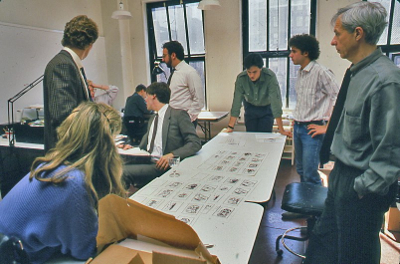
Ink Tank 1986
JJ: And by that time it was the mid-70s, '78? '77?
RO: Yeah.
JJ: Because "Soldier's Tale" was late '70s into '80?
RO: '78.
JJ: '78? Ok. And it took off from there. How did your relationship with the New Yorker start?
RO: Oh it was great. I think I submitted something - I still have the rough.
JJ: Who was the art director?
RO: Lee Lorenz.
PART 3 -
RO: What happened is, I mentioned this is a book that I wrote.
JJ: Is that book available on amazon for $4.95? [laughter]
RO: No I think it's [my book] “Behind The Lines”. What happened is I would submit stuff - I don't remember what in the world I submitted - but I would get these printed rejections and then once I got a rejection that didn't seem to be printed, it seemed to be type written and I gave the signature the saliva test and the damn thing blurred and I realized that I was rejected personally so, I didn't submit anything afterwards because I didn't want to return to the printed rejection slips - I'm there, I've arrived.
JJ: Do you remember who it was from?
RO: The person who preceded Lee Lorenz, whoever that was. But in any event, when Lee became the art director, which meant that he took care of covers and cartoons, I sent him something based on the adage 'the grass is always greener on the other side' and he accepted the damn thing, and so that started me. And so I did I guess either thirteen or fourteen covers for him, then he was replaced by Francois Mouly, Art Spiegelman's wife - which might have something to do with the fact that she was hired, but she had worked on Raw Magazine.
JJ: And this is probably the thing that you don't want to have printed, yeah?
RO: No, this is all on the record.
RO: Who's the English lady who took over?
JJ: Oh, Tina Brown. Oh she was the one who...
RO: She hired Francoise.
JJ: Oh, she hired Francoise, ok. Because I think a lot of people think you do more cartoons inside the New Yorker than you really do, because, I know you don't - I didn't think you did either because I've had to mention, 'no, I think most of the stuff RO Blechman does for the New Yorker is cover designs - and you've had posters made from your covers, I know in George Booth's apartment - in Sarah's apartment she has your poster up there. Do you think that the New Yorker has - well I know the New Yorker has really contributed to your reputation and your, I mean, I could remember when people used to come to the studio they'd think of you as being probably the premiere New Yorker cover designer - it's interesting though because around now, you're really - what would you say at this point, you're most known for?
RO: Alka Seltzer.
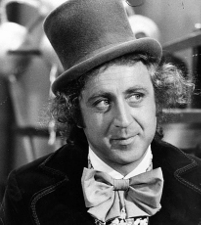
JJ: Really?
RO: I would say so. People introduce me as the guy who did the Alka Seltzer spot, isn't that interesting? What am I most known for? I don't think my stuff has been around that much in the last ten years really. It's been a quieter period in my career.
JJ: Because I think of you New York Times-wise.
RO: Oh, the New York Times I'm well known - I have not really done a lot of work for the New York Times. Their ed/art director has changed quite often, the new guy, Jim Datz, hasn't hired the older illustrators that I was part of - he doesn't call me and I can't call him so...
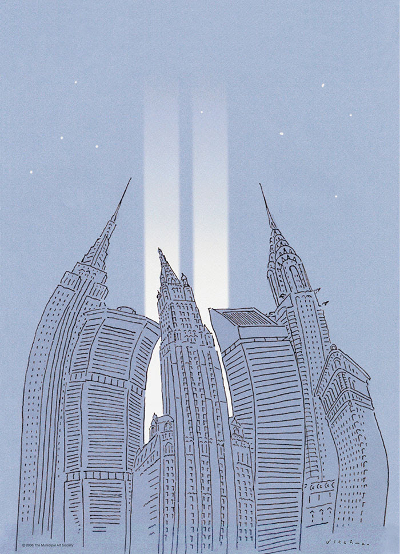
Appeared in the New York Times Op-Ed
JJ: Was there any other work that came after the WQXR [classic radio station] spot? That was another lovely spot.
RO: Oh that was Casey David. Fantastic. No, I was known for the Perrier [spot] of course.
JJ: Well they branded themselves with you almost, really.
RO: But I had a bad relationship with them in the sense that I wanted to move the layout and the design, the whole approach to something that's a little more designed - it was very copy heavy. And I actually gave it up, I said I don't want to do any more of this stuff. And I went to Europe for four months and when I returned I saw that an artist had replaced me copying my style, so I said, 'I'll go back to it', and they said, well, sure but we pay him a lot less, so we can't tell the client that it has to go back to the old weigh scale, so I said, yeah, well I have to do it.
JJ: How did you and how do you deal with the fact that you're imitated, ripped off and so forth?
RO: I don't care, it doesn't bother me much. It only bothers me when I think 'hey didn't I do that?' I'm not sure. And once I started a suit until my lawyer found out that the person who had imitated my style was a former student of mine for several years - so that took care of the suit. Most of the time I don't give a damn because I think the style is less important than the idea behind the style.
JJ: It's an interesting problem because anyone who has a style that's so immediately recognizable - if Ford decides to use someone ripping off RO Blechman, then chances are if Chrysler was considering using the real RO Blechman - so you're kind of losing work to someone that's doing your style.
RO: Well, Red Bull - I haven't seen any Red Bull but everybody congratulates me for my wonderful Red Bull commercials.
JJ: And there was another campaign that was going, that was uncomfortably close to your style - but there really isn't anything you can do.
RO: No, except watch television less. [laughs]
JJ: Well, yeah. Well is there anything else you want to say about working in commercial animation or design?
RO: Yeah, I enjoyed the stuff. It was very simple minded, very easy and it paid well - you can't beat that combination.
JJ: Also with the budgets the way they were it allows you to take on other work that you might not be able to take on.
RO: I would take this other work on anyway. No, I enjoyed it. What I didn't enjoy was the fact that who the hell knew the quality of the products that I had to advertise - that bothered me. I rarely turned a job down, but some of them bothered me somewhat - always somewhat. I took my somewhat regrets to the bank.
- END -
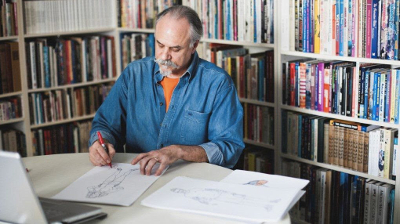
J.J. Sedelmaier
www.jjsedelmaier.com
J. J. Sedelmaier Productions, Inc. is a design and animation studio started by J. J. Sedelmaier and Patrice Sedelmaier in 1990. It produces both print campaigns and animated films in a variety of styles and techniques.
Transcription: Phoebe Smolin
Layout: Grace M. Lyon
PART 1 -
JJ: Okay so today is the 15 of March 2018 and I'm sitting here with RO Blechman who is, you know who he is - he's a legend and he's an amazing designer, artist, animation director, creator and plenty of points of view. How did you get started in advertising?
RO: I had to make a living and the way I could make the living and it's still true is the editorial paid very little, advertising paid a hell of a lot, and so I'd go around with my portfolio to advertising agencies and another reason I hit advertising agencies was that the first list I was given of people to see were people in advertising.
JJ: And this is at what time?
RO: 1954. What happened is I graduated college in '52...
JJ: You went to Oberlin?

JJ: We'll go into how that got produced because that's obviously had and incredible impact on everything.
RO: Yeah, but what happened is I read a biography of the famous American director, Frank Capra. And by the way, read his biography it's amazing. It was his autobiography, Be it as it may, he mentioned the fact that he worked for Colonel Slingo. I love the name, straight arrow animation. I got in touch with Colonel Slingo, sent him my book, and mentioned my qualifications and then when I was drafted, I was sent to camp Gordon in Georgia which I could do without - because basic training in the Georgian jungle was no fun but I was given, after basic training, an MOS - Military Occupational Specialty - it was a dream. I was assigned to the film school, the film school was in Astoria New York.
JJ: Oh, part of the Signal Corps?
RO: Yeah. A dream. And I turned it down. I turned it down because I was told that I'd be in the front lines not with a rifle, but with a camera, and I said not for me - it was all bullshit and I should have known better and maybe part of me did know better but at least I was sent to Germany but imagine, JJ, if I had gone there I would be a live action film director and probably a god damned good one too, it was a career-changing mistake, just something I continually mistake - that's very interesting - something I continually mistake - something I continually make mistakes about, that's another matter. In any event...
JJ: If that had happened you think that would've taken you away from design and your graphic work? And you would have just been...

JJ: But perhaps you would have - you've taken the graphic aspect of your storytelling into areas that no one else has and you do work that no one else could even hope to do so, just so you know, I think there are a lot of people that are really happy you didn't go into the signal corps.
RO: Well and I'm not one [laughter]. In any event, I would be doing feature films and...
JJ: Which is something you've always wanted to do.
RO: I've always wanted to do. Why don't you go to the next questions. [laughter]
JJ: Okay so you found yourself - you had done "The Juggler of Our Lady", which kind of put you on the map.
RO: Oh, the book.
JJ: Yeah, the book.
RO: Well the book led to my first job and that was with John Hubley at Storyboard, right after I got out of the army. Hubley invited me to lunch and said 'would you like to join my outfit, Storyboard Inc., doing storyboards?' So that's what I did for a year and a half probably - god damn good pay.
PART 2 -
JJ: Ok, so how did "The Juggler of Our Lady" the book happen?
RO: In college I took a special seminar on humor, of all things - I'm talking about of all things the professor I later learned was a colleague of Luis Buñuel, because I read Luis Buñuel’s autobiography and there was my professor's name. And at the end of the seminar we all had to create projects, I did a graphic novel - it was...
JJ: Before there were even things called graphic novels.

JJ: Did you have to get any sort of rights or was it all just public domain?
RO: No, Anatole was 19th century so, yeah. They accepted it - all this before I went into the army in 1953- it was fall 1952 and, by the way, the guy who suggested that I go to Henry Holt who was the book jacket designer, did the book jacket for the "Juggler Of Our Lady" and I hated it - it was awful, but I was in the army by the time it was published so I couldn't do my own jacket, it really bothered me.
JJ: Any reaction to the simplicity, sparse style that you were working in?
RO: Yeah, well I had done political cartoons for the college newspaper - and all the stuff was political because I was a very political cat at the time - something of a so-called democratic socialist. Norman Thomas came to speak, he was fantastic by the way, it was - sorry to get off the subject, but he was debating a republican congressman and when the republican congressman was speaking his talk was interrupted by laughter from the audience and the guy was all upset and hardly could carry on. And what happened was while the other was speaking, Norman Thomas was conspicuously picking his nose. [laughter] That guy knew what attracted attention. In any event, no my brain was rotten for many years after, it took a while for me to get to where it is now - my style.
JJ: But the Reaction to your drawings and your layout and your...
RO: Oh it was novel. It was, yeah...
JJ: And he recognized it and it was something that he took to, it wasn't something like, 'well, aren't you going to do more of this?'

JJ: So did the book just take off from the time it was released?
RO: It did. I will never forget and it was very disabling to get that kind of recognition when you're not ready for it. But I remember one sunday, we got the Sunday Herald Tribune and the front page was 'oh my god it's the "The Juggler of Our Lady"! I couldn't believe it.
JJ: And was it because it was a novel approach?
RO: Yeah, I mean, in truth there had been graphic novels before and as you well know, you could probably name a few. Milt Gross, didn't he do a graphic novel?
JJ: Yeah, “He Done Her Wrong” without any text.
RO: Yeah he didn't know anything about graphic novels, I didn't know anything, just coincidentally both happened to come across the creative form.
JJ: They were just illustrated books, they were just cartoons.
RO: Exactly.
JJ: So you had an established existence as a successful cartoonist.
RO: Age twenty-two.
JJ: Age twenty-two! Did you ever have any problem with being called a cartoonist?
RO: No I didn't even care. I mean, Saul Steinberg - that he was called a cartoonist - if it was good enough for him it's fine with me. It's the work that counts who cares how it's classified or described.
JJ: So Hubley saw "The Juggler of Our Lady"?
RO: Yeah.
JJ: And he had Storyboard and...
RO: Yeah and he asked me to do storyboards so that's what I did, but my style was never used - it would go to people like Tony Eastman's father.
JJ: Got ya. Phil Eastman, ok.
RO: Yeah because my stuff was very commercial and also it was then difficult to animate - all this broken line stuff.
JJ: Was it John Hubley who said, "We can animate your stuff, it doesn't make any difference"?
RO: Well he did, yeah, there was a live action short with Dizzie Gillespie, it was Dizzy Gillespie playing an advertising executive who was showing a rough to a client and the rough happened to be my rough animation and it was animated by Bill Littlejohn.
JJ: Oh wow!
RO: Oh wow is right!
JJ: Who you worked with well into the 80s and probably 90s.
In 1984, R. O. Blechman designed and directed an animated version of "The Soldier's Tale" for PBS's Great Performances, featuring the Oscar nominated actor Max von Sydow ("Game of Thrones") as the voice of the devil. The animated, one-hour adaptation of composer Igor Stravinsky's and playwright C. F. Ramuz's theater masterpiece, "L'Histoire du Soldat", won the Emmy Award for Outstanding Individual Achievement - Animated Programming. In 2003 the film was screened at MoMA, accompanied live by the Manhattan Chamber Orchestra.
RO: Oh yeah, I remember he once did a marvelous sequence for this Stravinsky "Soldier's Tale" and he called me up and he said, "Hey, if you don't want to use it you don't have to because I don't like it". And I said, you have to be kidding this stuff is great! "Well are you sure?" Yeah! And there he was in California animating it - these are animators who just take off, you give them an idea and they're off and running. They contribute, they add this stuff, and that's the mark of any good craftsman.
JJ: That's also what's interesting about the "Soldier's Tale", is you can tell all the different animators that worked on your stuff by looking at the sequence but it all holds together just beautifully.
RO: every now and then Tissa [David] would come in and add a little something but it does hold together I mean I still grim-MASS when I come across it.
JJ: Most people grimace by the way.
RO: Ok!
JJ: Because you're beside yourself. [laughter]
RO: It's so bad I have to grimace! But no, it works because the story goes all over the place and the music goes all over the place so the animation goes all over the place although sometimes the animation is a very banal standard - I can't find the word - conventional - but you know I had just so much money - which is so little money- and I had to do what I had to do and so I wasn't able to use Tissa David and Bill Littlejohn and Ed Smith and some of the other wonderful animators whose names I'll forget, unfortunately. So I had to use people who were around.
JJ: No, it came out great, it still came out great!
RO: Yeah it was a fine film.
JJ: So did this particular project come up after the Gillespie thing?
RO: That was done after I was there for many many months, maybe I was there for a year. No, you wanted to do a live action film with Dizzy Gillespie and you wanted this animation and he wanted it to be bad and he used my style.
JJ: He wanted it to look like just rough and naive or...
RO: In other words, Dizzy Gillespie is selling the client a rotten project and the rotten project has a rotten drawing so that was the fun of it, but it got me out to California for a week or two, working with Bill Littlejohn

RO: No.
JJ: Because it doesn't sound like something I've ever seen either. And so when...
RO: It was called, "Date with Dizzy".
JJ: Ok and this is in '54?
RO: Yeah.
JJ: Ok. And so when did you start getting commercial animation work on a semi regular basis after that?
RO: After that, yeah. What happened, it's very interesting - I would do storyboards for Elektra films.
JJ: Elektra was on...
RO: 46th street.
JJ: And it was...
RO: Abe Liss.
JJ: Abe Liss and Sam Magdoff.
RO: So what happened is I wasn't very happy sometimes with the way my storyboards were turned into key drawings.
JJ: So they would take your storyboards and do a kind of pseudo-Blechman looking...
RO: Yeah, probably wasn't bad, but I said, 'look I'll do this stuff', so after doing the key drawings Iand figures, why don't I do the in-between stuff? And so I realized, what the hell, I'm doing films!
JJ: So you were actually animating at that time?
RO: No - good for you [laughter]. I worked, I don't remember what, very good question you were asking. I only know that I ended up doing the drawings, I was not animating, I never have animated, but I figured, look if I do the storyboard and if I do - I guess I had done the animation, somebody had done the animation for me - then I re-drew it, and then I figured it's a film. So then I started getting work on my own - I don’t know how - that's a step I can't...
JJ: Well Elektra was a relatively artsy studio.
RO: Very good.

RO: No, I never did work for any other studios in New York.
JJ: Pelican at all? With Jack Zander?
RO: Jack Zander - I know the guy - I don't remember having ever worked for him. I don't remember having worked for anybody but Elektra. What I don't know is how the hell I ever transitioned into my own studio, I do not know.
JJ: Well that had to do with PBS, right?
RO: No.
JJ: Because Elektra would have taken you into the '60's. And by Elektra, I mean, Seymour Chwast was designing their posters.
RO: No, I think something else happened that got me into it. I think what happened was - and this was the beginning of the Ink Tank - I was with the head of PBS, Larry Gorshman, and it happened that he had seen my first cover for the New Yorker. And I don't know where, how and why we met - and I say hey Larry PBS doesn't have a Christmas show- why don't you do a Christmas show? That was when I really started my own animation studio. I used a lot of the people and others who had worked on the film as the animators.
JJ: So what I'm trying to do is fill in the area between Elektra - now Elektra took you- Elektra did Alka Seltzer?
RO: What a good question, yes, of course.
JJ: Ok so it was Elektra?
RO: No question.
JJ: Tinker was the agency and Partners I think? And then you also knew Lou Dorfsman. So the CBS stuff probably came before that?
RO: That was something different. I don't know when I did the CBS spot.
JJ: Late '67? Something like that.
The CBS Christmas Message was conceived, designed and directed by R.O. Blechman and animated by Willis Pyle (whose long career in animation included working on the Disney classics "Pinocchio", "Bambi" and "Fantasia").
RO: I think so. What happened is, during the holiday season I was at a theatre and I saw that the audience was given a Christmas greeting, which was a slide and I thought to myself, 'this is weird' you know it's 1960-something. What the hell is a 1920s slide doing, so on my own I think I worked with - of course I worked with Electra on that. I had taken a Christmas card I had done, it was a two-page folder - and created a board, and managed to point out, it was Jack Dazzo who animated it.
JJ: Willis Pyle did the Christmas tree, Alka Seltzer was [animated by] Jack Dazzo though.
RO: Thank you. Well in any event it was Elektra who produced it, who financed it really.
JJ: So you pitched the idea to them and it was like a generic thing?
RO: That is correct.

Photo of JJ Sedelmaier and RO Blechman by William Duke 1987
RO: No, I pitched it to Lou.
JJ: You pitched it to Lou.
RO: Because I owned it. But how the hell did I own it and they produced it? I don't know.
JJ: Well that's rare but maybe you worked out an arrangement because there were a couple of them - there was the Christmas tree and there was the little girl with the escalator and the Santa.
RO: Much, much later.
JJ: But that was working off of the fact that "Christmas Tree" was probably successful and they said let's do another one and?
RO: Yeah.
JJ: And Lou was this incredible creative director at CBS that was just involved with their whole branding and image and everything. A fantastic guy.
RO: I'm gonna show you something that was done by Lou, I wish I had it handy. Yeah, here it is. Look at this booklet. So elegant, look at that glassy cover [looking at booklet].
JJ: Oh that's wonderful.
RO: Such a shame this isn't a video piece, but isn't it just - but look at that.
JJ: Yeah, he did some wonderful work. It's really incredible work.
RO: Yeah, he was an amazing guy. So I ended up renting it, for years and years and years.
JJ: And it really is - as far as I'm concerned, that CBS Christmas tree piece is one of your best. It's, like you were saying earlier, everything from design to animation to track, too. Oh it's just fantastic. So by this time, late '60s, Electra was starting to go, Electra maybe made it into the early 70s?

"A Soldier's Tale" Crew - 1984
JJ: Actually a lot of - especially animation studios - they feel this obligation to get larger and take on more stuff and more responsibility and they just explode. Colossal Pictures suffered from the same thing, too. Wonderful studio but they just got into everything from Merchandise to long form shows and they no longer had this special existence any longer. But I think of the, OK so we have Alka Seltzer, CBS, Volvo...
RO: Oh that came quite a bit later but that was very important. Volvo, yeah that was Elektra also, how about that.
JJ: How did you meet Tissa?
RO: I don't know.
JJ: Really?
RO: I know how I met Ed (Smith).
JJ: How'd you meet Ed?
RO: I heard about him and so I asked to meet him and in lumbered this great big guy
JJ: He is a bear
RO: And I thought to myself no way is he going to handle my stuff. But I needed to have an animator and he turned out to be Ed Smith. I remember also that in 1960 I happened to be in Spain watching a Flamenco show and the main performer was this really overweight lady and I thought- let's leave - and then she started dancing - I was transfixed with that flamenco dancer.
JJ: Oliver Hardy was very light on his feet as well for being as big as he was. But Tissa did - it's interesting because Ed and Tissa I think of as your two [animators] - I know Bill Littlejohn did a lot of stuff; I know a lot of people have done stuff but those two are the ones that really seem to capture your style and what's interesting.
RO: They expanded on it
JJ: They all do, all good animators do, absolutely. First of all, Ed worked straight ahead, meaning he just puts the pencil down and he just starts going - no in-betweens, no breakdowns, just whoosh - goes straight ahead. Tissa breaks things down. Also Ed articulates - he uses fingers. Tissa has these mitts and they have a completely different style but they both really capture your feeling and move it forward and all of that stuff.
RO : They add.
A 1980's TV commercial for Perrier water - known as "Earth's first soft drink" and features an animated caveman who speaks French rather than Neanderthal gibberish!
JJ: But Tissa did Perrier right?
RO: Yes, of course.
JJ: Did she do anything before Perrier?

Ray Favata's photograph of the legendary animator Tissa David, animator of the Perrier commercial. Her career in animation spanned over three decades, including animating the Raggedy Ann character for the 1977 film, "Raggedy Ann & Andy," directed by Richard Williams. She was awarded the Winsor McCay Award during the 1988 Annie Awards.
RO: Probably. But offhand I don't know what she had done. But whenever I could, I worked with Tissa. Both very emotional animators.
JJ: Thank god!
RO: They move into my character, they inhabit my character.
JJ: Well, again, all good animators do that.
RO: Yes, that is very true - I think animators get shorted - it bothers the hell out of me. [People] think they just go move something - no, they don't. They act it out.
JJ: Yeah, you really can also cast animators to do certain projects, like you wouldn't necessarily cast Tony Eastman for the same thing you would cast Tissa David for. I remember Tissa animated a tango for us and I asked her ahead of time 'have you ever animated a tango?' and she said “J.J. – I DEED the Tango !”. And I knew I had the right person.
RO: I know that she animated a rock spot and, boy, she was fantastic. That was a music video for I think They Might Be Giants and she was fabulous.
JJ: It's interesting because you mention that you owned the [CBS] tree animation but animators, certainly not animators, but production companies and often even designers and illustrators don't end up owning the stuff that they do. And they certainly don't have an arrangement like actors or voiceover people have in terms of residuals in commercials.
RO: I tried doing it once by the way. I did a spot for PanAm and I did get residuals.
JJ: You did?
RO: Yeah
JJ: As the illustrator?
RO: Yeah, but the money was so little and it was so difficult to negotiate with them I decided to hell with it.
JJ: I also heard that at one point the animation union, which went belly up in the early '90s, it was going... it started when Fleischer had problems in the '30s, but I think they came to a point in the early '60s or something where they could either get residuals for their animators or there was something else that they traded off for that - and it all had to do with the relationships they had with the advertising agencies, of course. But I don't know what the circumstances were. But it was “Simple Gifts” that formed the Ink Tank and that was a holiday special for PBS and was that [animated by] Chloe Aaron?
RO: Yeah
JJ: What ever happened to Chloe?
RO: I don't know.
JJ: I thought she was terrific. I remember she used to live on 13th off of Broadway
RO: Well she used to live in the building where I lived before I moved here. Yeah, 64th Central Park West. Chloe was a funny person. I remember that in the middle of "The Soldier's Tale" production I couldn't get financing and I spoke to somebody at Great Performances and I was turned down - and told Chloe this and Chloe said, "let me take care of it". I got the financing. Otherwise it wouldn't had been made - I ran out of money. I put I think $750,000 into that thing and half came from the studio. Yeah, Great Performances saved it.
JJ: But "Simple Gifts" was a conglomeration of different artists with story and it was Maurice Sendak and...
RO: Seymour Chwast.
JJ: Seymour Chwast, Slackman?
RO: Slackman. He was wonderful. James McMullan, my favorite. His film was unreal. There was an incident in WW1 at the very beginning during Christmas, the German and British soldiers laid down their arms and played soccer. And I remember one thing - the very first segment by Maurice Sendak, consisted of still photographs - and we didn't want still photographs we wanted everyone to be animated and the guy called me at home at night and he was so convincing that I agreed.
JJ: The guy from PBS?
RO: No, I'm sorry, the guy who conceived of this project, it was based on Moss Hart’s autobiography, act one. It was a beautifully told thing. And I just was so impressed by his fervor about this thing that I said, 'OK let's go with it'. Very good decision.
JJ: Yeah, I remember the poster was like maybe one of the early Ink Tank posters where it was like an 8-finger hand with all the different...
RO: That came a little later - that was Seymour Chwast.
JJ: That was Seymour Chwast? But you had all the different artists who had signed their fingertips.
RO: What I can't believe is that I think I actually got everybody to sign except for Maurice Sendak. I gave it to Washington University, like everything. I'm glad.
JJ: So when "Simple Gifts" was over you didn't want to disband all of this great talent and...
RO: And then after a while I decided what the hell, I'll animate everything by anyone - a job's a job.
JJ: And it was kind of a combination of taking the sensibility of everything from Elektra to Push Pin, gathering these talents - but there weren't a lot of people doing animation and cartoons in styles like that, were there?
RO: I don't know.
JJ: I don't think so. So you just decided to open The Ink Tank from there?
RO: Yeah.

Ink Tank 1986
RO: Yeah.
JJ: Because "Soldier's Tale" was late '70s into '80?
RO: '78.
JJ: '78? Ok. And it took off from there. How did your relationship with the New Yorker start?
RO: Oh it was great. I think I submitted something - I still have the rough.
JJ: Who was the art director?
RO: Lee Lorenz.
PART 3 -
RO: What happened is, I mentioned this is a book that I wrote.
JJ: Is that book available on amazon for $4.95? [laughter]
RO: No I think it's [my book] “Behind The Lines”. What happened is I would submit stuff - I don't remember what in the world I submitted - but I would get these printed rejections and then once I got a rejection that didn't seem to be printed, it seemed to be type written and I gave the signature the saliva test and the damn thing blurred and I realized that I was rejected personally so, I didn't submit anything afterwards because I didn't want to return to the printed rejection slips - I'm there, I've arrived.
JJ: Do you remember who it was from?
RO: The person who preceded Lee Lorenz, whoever that was. But in any event, when Lee became the art director, which meant that he took care of covers and cartoons, I sent him something based on the adage 'the grass is always greener on the other side' and he accepted the damn thing, and so that started me. And so I did I guess either thirteen or fourteen covers for him, then he was replaced by Francois Mouly, Art Spiegelman's wife - which might have something to do with the fact that she was hired, but she had worked on Raw Magazine.
JJ: And this is probably the thing that you don't want to have printed, yeah?
RO: No, this is all on the record.
RO: Who's the English lady who took over?
JJ: Oh, Tina Brown. Oh she was the one who...
RO: She hired Francoise.
JJ: Oh, she hired Francoise, ok. Because I think a lot of people think you do more cartoons inside the New Yorker than you really do, because, I know you don't - I didn't think you did either because I've had to mention, 'no, I think most of the stuff RO Blechman does for the New Yorker is cover designs - and you've had posters made from your covers, I know in George Booth's apartment - in Sarah's apartment she has your poster up there. Do you think that the New Yorker has - well I know the New Yorker has really contributed to your reputation and your, I mean, I could remember when people used to come to the studio they'd think of you as being probably the premiere New Yorker cover designer - it's interesting though because around now, you're really - what would you say at this point, you're most known for?
RO: Alka Seltzer.

Gene Wilder voiced the stomach, the same year he starred in Mel Brooks, 1967 "The Producers". Shown here a few years later in "Willy Wonka and the Chocolate Factory".
JJ: Really?
RO: I would say so. People introduce me as the guy who did the Alka Seltzer spot, isn't that interesting? What am I most known for? I don't think my stuff has been around that much in the last ten years really. It's been a quieter period in my career.
JJ: Because I think of you New York Times-wise.
RO: Oh, the New York Times I'm well known - I have not really done a lot of work for the New York Times. Their ed/art director has changed quite often, the new guy, Jim Datz, hasn't hired the older illustrators that I was part of - he doesn't call me and I can't call him so...

Appeared in the New York Times Op-Ed
RO: Oh that was Casey David. Fantastic. No, I was known for the Perrier [spot] of course.
JJ: Well they branded themselves with you almost, really.
RO: But I had a bad relationship with them in the sense that I wanted to move the layout and the design, the whole approach to something that's a little more designed - it was very copy heavy. And I actually gave it up, I said I don't want to do any more of this stuff. And I went to Europe for four months and when I returned I saw that an artist had replaced me copying my style, so I said, 'I'll go back to it', and they said, well, sure but we pay him a lot less, so we can't tell the client that it has to go back to the old weigh scale, so I said, yeah, well I have to do it.
JJ: How did you and how do you deal with the fact that you're imitated, ripped off and so forth?
RO: I don't care, it doesn't bother me much. It only bothers me when I think 'hey didn't I do that?' I'm not sure. And once I started a suit until my lawyer found out that the person who had imitated my style was a former student of mine for several years - so that took care of the suit. Most of the time I don't give a damn because I think the style is less important than the idea behind the style.
JJ: It's an interesting problem because anyone who has a style that's so immediately recognizable - if Ford decides to use someone ripping off RO Blechman, then chances are if Chrysler was considering using the real RO Blechman - so you're kind of losing work to someone that's doing your style.
RO: Well, Red Bull - I haven't seen any Red Bull but everybody congratulates me for my wonderful Red Bull commercials.
JJ: And there was another campaign that was going, that was uncomfortably close to your style - but there really isn't anything you can do.
RO: No, except watch television less. [laughs]
JJ: Well, yeah. Well is there anything else you want to say about working in commercial animation or design?
RO: Yeah, I enjoyed the stuff. It was very simple minded, very easy and it paid well - you can't beat that combination.
JJ: Also with the budgets the way they were it allows you to take on other work that you might not be able to take on.
RO: I would take this other work on anyway. No, I enjoyed it. What I didn't enjoy was the fact that who the hell knew the quality of the products that I had to advertise - that bothered me. I rarely turned a job down, but some of them bothered me somewhat - always somewhat. I took my somewhat regrets to the bank.
- END -

J.J. Sedelmaier
www.jjsedelmaier.com
J. J. Sedelmaier Productions, Inc. is a design and animation studio started by J. J. Sedelmaier and Patrice Sedelmaier in 1990. It produces both print campaigns and animated films in a variety of styles and techniques.
Transcription: Phoebe Smolin
Layout: Grace M. Lyon
